- Products
- Solutions
- Services
- Resources
- Customer Success
- Company
- Sign In
- Contact Us

Digital Transformation enabler helping enterprises evolve by connecting technology
Take a look at upcoming webinars and special events
HokuApps news and media coverage
Be with the best. Solve real problems
Get in touch with our experts here
Explore our extensive collection of online resources here
Information and insight on transformation to the Digital Workplace
Quick Guides provide concise information on a variety of topics
Discover the essence of HokuApps’ products
Learn all about HokuApps’ cutting-edge enterprise mobility technology

It can be the urge to skip the queue at your favorite coffee shop, or a remedy for your forgetfulness for switching off appliances before leaving home. The idea for a great mobile app may be hidden in the next everyday obstacle you face. In fact, the most popular apps are actually outcomes of research dedicated towards the deep-seated need to simplify life. With as many unique instances as there are people facing them, it is no surprise there are over 5 million apps across app marketplaces.
Needless to mention here that all 4.8 million apps have not left their mark. Some have been forgotten easily, while some last little longer till an enticing competitor steals their customer’s attention. A recent report found that an average smartphone user approximately utilizes around 10 apps on a daily basis. While this is largely dependent on the demographic segregation, there is another overarching reason for some apps to be more successful over others. And that is the user experience! It can be rightly considered as the first impression of the app in terms of usability.
However, apps that are easy on the eye have a higher chance of success and that is where the design of the mobile app comes to play. The UI/UX aspect of mobile app design has thus placed itself as the driving force behind the success — or failure — of an app.
To say that there is a specific way to craft an impeccable design for your app is like saying there is only one way to top your pizza. A good mobile app design requires various elements to come together: elements that serve the core functionalities of an app. However, there are a few methods that will allow you to improve the look and feel of your app.
Here’s the HokuApps short guide to creating mobile app designs and development:

One of the essential steps towards designing an app is to be an app user yourself. Your role as a user will teach you what you like and dislike about apps. More so, for apps that are built on principles that match your liking. Few of the factors that you would be looking out as a user are fonts, color schemes, and the flow of navigation. This is a great way to get some useful research done in the smartphone application domain.
In case of mobile app designers, the dominating platforms are Android and iOS, followed by Windows. Each of these platforms has their unique advantages and pitfalls. Research on existing apps is a great way to get an idea of what works and what does not.
Mobile applications and the platforms used for producing them are a fairly young field. The possibilities of impactful designs are endless. Keeping this in mind, let your creativity take the front seat during the ideation process.
During the ideation stage, you are essentially defining the purpose and personality of your application. Each aspect of the app must have a clearly defined motive, be it in-app-purchases or other utilities.
With over 3 million apps on the Google Play Store and another 2 million on the iOS App Store, chances are that you will have apps that are similar to yours. It is always a smart option to scout out your competition. One of the best practices is to go through user reviews and suggestions for these apps. A strength, weakness, opportunities, and weakness (SWOT) analysis of the current app ecosystem will reveal a great deal of information on what to avoid and what to capitalize on. Competition analysis can also reveal the secret to update cycles for the app and how to live up to dynamic customer expectations. This could also translate to a strategic advantage, allowing you to place your release a few days ahead of an update from your competitor.
The abundance of successful mobile app designs is no secret. However, you want your app to be unique as well as simple to use. Visual inspiration plays an important role in this. Few of the features from leading apps can be a great source for learning. Particularly in terms of UI, expressions like gestures and ergonomic placement of elements across the mobile screen are only some of these features.
Before you start implementing your mobile app design, it is a good idea to lay down your ideas on a piece of paper – thereby, creating a wireframe. A wireframe is the most basic visual projection of the concept of the app. Creating one is an important step towards identifying various obstacles that you may face during the development phase. This stage can reveal any excess costs you might face or even an extension in the timeline of the project.
Once you have created the wireframe, and have a thorough understanding of how the app will progress from here on, you are ready to design your app. The mobile app design phase is where your research and ideation are put to practical use. Some of the factors that have to keep in mind during the design phase are the functionalities of each of the elements used for your app. A cluttered interface can cause unnecessary interruptions to the user interface. On the other hand, lack of necessary features is an even more potent evil.

The current mobile application landscape demands decision makers to be quick on their feet while assessing market needs. This calls for mobile app development companies to employ a rapid and iterative method of app development. This is why HokuApps has automated its mobile application development process.
Platforms such as HokuApps offer mobile apps designed especially for this. Employing a comprehensive tool like HokuApps MADP solution allows a low-code approach to app design and development. The platform enables designers to quickly implement their designs from a design studio through a visual drag and drop model. The platform comes featured with a design studio that contains hundreds of designs based on guidelines put forth by Apple and Google. The reusability of resources such as business modules, technology components and designs, reduces the chances of budget extension while increasing app deployment by 10 times. A stark differentiation to traditional mobile app development platform, where each app is developed and designed from scratch.
MAD platforms ensure system integrity across platforms and legacy systems. In addition, a solution such as that offered by HokuApps on its automated platform reduces the dev-to-market time, is affordable, reliable and offer highly customized solutions to suit a business’s every unique requirement.
On traditional app development platforms, design and development of mobile apps is not an easy process. But with HokuApps, app design and development is easy as mobile app design fits user expectations, follow current technology and business trends, and perhaps surpass the features of those that are already well accepted. Choosing the right platform helps significantly in this case. So, the next idea you have does not have to remain on paper.